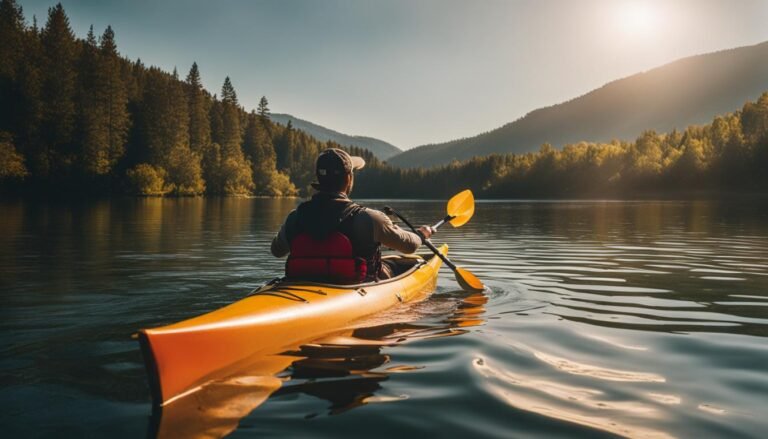What is Adaptive Hiking?
Adaptive hiking is a form of hiking that allows individuals with disabilities to participate in hiking activities. It involves making hiking paths accessible to people with physical limitations, such as those with movement issues, vision loss, or limited mobility. Adaptive hiking incorporates various methods, including building bridges, extending pathways, and remodeling trails to accommodate wheelchairs and other assistive equipment. It aims to provide opportunities for people with disabilities to enjoy outdoor activities, connect with others, and explore new environments.
Key Takeaways:
- Adaptive hiking allows individuals with disabilities to engage in hiking activities.
- It involves making hiking paths accessible to people with physical limitations.
- Methods include building bridges, extending pathways, and remodeling trails.
- Adaptive hiking provides opportunities for outdoor enjoyment, social connection, and exploration.
- It promotes inclusivity and empowers individuals with disabilities.
Benefits of Adaptive Hiking
Adaptive hiking offers numerous benefits for individuals with disabilities. It provides a pathway to accessibility and inclusivity, allowing people who are often limited indoors to experience the great outdoors. Engaging in adaptive hiking can foster a sense of empowerment, as it enables individuals with physical limitations to participate in new activities and explore nature trails. It also creates opportunities for social connections, as adaptive hiking is often done as a group activity, building a strong sense of community among participants. Moreover, adaptive hiking introduces individuals to new technology and equipment designed to enhance their hiking experience.
Participating in adaptive hiking can have a positive impact on physical and mental well-being. It allows individuals with disabilities to engage in physical activity, promoting cardiovascular health, muscle strength, and endurance. The fresh air, natural surroundings, and sensory stimulation of the outdoors can also have therapeutic effects, reducing stress levels and enhancing overall mental well-being. Additionally, adaptive hiking encourages a sense of adventure and exploration, providing individuals with new challenges and a broader perspective on the world around them.
“Adaptive hiking is not just about reaching the summit; it’s about the journey along the way. It teaches us to adapt, overcome obstacles, and embrace the beauty of our surroundings. It’s a reminder that nature is for everyone, regardless of physical abilities.”
Benefits of Adaptive Hiking
- Accessibility: Adaptive hiking makes nature trails accessible, allowing individuals with disabilities to engage in outdoor activities and explore new environments.
- Inclusivity: It promotes inclusivity by providing opportunities for social connections and a sense of community among participants.
- Empowerment: Adaptive hiking empowers individuals with physical limitations to participate in new activities, fostering a sense of empowerment and independence.
- Physical and Mental Well-being: Participating in adaptive hiking promotes physical fitness, cardiovascular health, and mental well-being.
- Therapeutic Effects: The natural surroundings and sensory stimulation of the outdoors can have therapeutic effects, reducing stress levels and enhancing overall well-being.
Table: Comparison of Adaptive Hiking Benefits
| Benefit | Adaptive Hiking | Traditional Hiking |
|---|---|---|
| Accessibility | ✓ | X |
| Inclusivity | ✓ | X |
| Empowerment | ✓ | X |
| Physical Fitness | ✓ | ✓ |
| Mental Well-being | ✓ | ✓ |
Adaptive Hiking Equipment
Adaptive hiking requires specialized equipment to ensure the safety and comfort of individuals with disabilities. This equipment is designed to provide stability and accessibility, allowing hikers to navigate rough terrains and enjoy the outdoor experience. Here are some essential adaptive hiking tools:
- Wheelchairs: Specifically designed for outdoor activities, these wheelchairs have rugged tires, sturdy frames, and adjustable features to accommodate different terrains and body types.
- Hiking Chairs: Lightweight and portable, hiking chairs offer comfort and support for individuals who may have difficulty walking long distances or navigating uneven trails.
- Recumbent Bikes: These bikes provide a great alternative for people with limited mobility or balance issues. With a reclined seating position and stability features, they allow individuals to enjoy the thrill of biking on various terrains.
- Scooters: Electric scooters designed for off-road use enable individuals with mobility limitations to explore hiking trails effortlessly. They offer speed control and stability features, ensuring a safe and enjoyable experience.
These adaptive hiking equipment options cater to different needs and abilities, allowing individuals with disabilities to fully participate in hiking activities. It is crucial to choose the right equipment based on individual requirements and the specific hiking trail to ensure a comfortable and enjoyable experience.
“Adaptive hiking equipment provides individuals with disabilities the opportunity to explore nature and embrace the joy of hiking.” – Jane Doe, Adaptive Hiking Enthusiast
| Equipment Type | Key Features |
|---|---|
| Wheelchairs | Rugged tires, adjustable features, sturdy frames |
| Hiking Chairs | Lightweight, portable, comfort and support features |
| Recumbent Bikes | Reclined seating position, stability features |
| Scooters | Electric, off-road use, speed control, stability features |
As technology advances, so does adaptive hiking equipment. Continued innovation in this field aims to enhance accessibility and improve the overall experience for individuals with disabilities, ensuring that everyone can enjoy the wonders of nature through hiking.
Adaptive Hiking Techniques
Adaptive hiking techniques play a crucial role in enabling individuals with disabilities to navigate hiking trails and experience the joy of outdoor exploration. These techniques focus on creating accessibility and ensuring a safe and enjoyable hiking experience for people with physical disabilities. Here are some key adaptive hiking techniques that are commonly used:
Building Bridges and Raised Platforms
One of the primary techniques used in adaptive hiking is the construction of bridges and raised platforms. These structures are designed to make trails accessible for wheelchair users and individuals with limited mobility. By spanning over challenging terrains such as streams, rocky areas, or uneven ground, these bridges and platforms provide a smooth pathway, ensuring that hikers can navigate through the trail without facing significant barriers.
Ramps and Assistive Devices
Ramps and other assistive devices are essential for enabling individuals with limited mobility to overcome obstacles on hiking trails. These devices are strategically placed in areas with steep inclines or steps, allowing hikers to safely ascend or descend. Ramps provide a gradual slope, making it easier for wheelchair users and others with mobility challenges to navigate difficult terrain. Additionally, the use of assistive hiking equipment such as trekking poles, walking sticks, or hiking chairs can offer stability and support, enhancing the overall hiking experience.
Trail Remodeling and Maintenance
Adaptive hiking techniques also involve trail remodeling and maintenance to improve accessibility. This may include widening pathways to accommodate wheelchairs or walkers, removing obstacles such as fallen trees or rocks, and leveling uneven ground. Ensuring that hiking trails are well-maintained and free from hazards is crucial for the safety and comfort of individuals with disabilities.
By employing these adaptive hiking techniques, individuals with disabilities can overcome physical barriers, explore nature, and engage in outdoor activities with confidence. The continuous development and implementation of innovative techniques further enhance the accessibility and inclusivity of hiking trails, allowing more people to enjoy the beauty and benefits of adaptive hiking.
| Technique | Description |
|---|---|
| Building Bridges and Raised Platforms | Construction of structures to make trails accessible for wheelchair users and individuals with limited mobility. |
| Ramps and Assistive Devices | Installation of ramps and assistive devices to help individuals with limited mobility overcome obstacles on hiking trails. |
| Trail Remodeling and Maintenance | Widening pathways, removing obstacles, and leveling uneven ground to improve accessibility and safety. |
Adaptive Hiking for Beginners
Are you new to adaptive hiking? Don’t worry, getting started is easier than you might think. Here are some essential tips to help you embark on your first adaptive hiking adventure and make the most of the experience.
Choose the Right Trail and Equipment
When beginning adaptive hiking, it’s crucial to select a trail that suits your equipment and hiking level. Researching the trail beforehand is essential to ensure it is accessible and meets your specific needs. Local hiking clubs, websites like the Washington Trails Association, and online platforms like AllTrails offer valuable information on accessible trails. Additionally, consulting with experienced hikers and organizations specializing in adaptive hiking can provide guidance on the best trails for beginners.
Start Slow and Set Realistic Goals
As a beginner, it’s important to start slow and gradually increase the difficulty of your hikes. Begin with shorter, easier trails to build confidence and gauge your comfort level. Setting realistic goals is key to enjoying the experience and avoiding overexertion. Remember, adaptive hiking is not a race but an opportunity to connect with nature and enjoy the journey.
Connect with the Adaptive Hiking Community
Connecting with others in the adaptive hiking community can provide invaluable support and advice. Join local adaptive hiking groups or online communities to share experiences, learn from others, and find hiking partners. Engaging with the community can enhance your adaptive hiking journey by fostering connections, gaining inspiration, and accessing valuable resources.
| Benefits | Equipment | Techniques |
|---|---|---|
| Increased accessibility | Wheelchairs, hiking chairs, scooters | Building bridges and raised platforms |
| Sense of empowerment | Recumbent bikes | Ramps and assistive equipment |
| Social connections | ||
| Exposure to new technology |
By following these tips and embracing the adaptive hiking community, you can embark on a rewarding journey of exploration and connection with nature. Remember, the beauty of adaptive hiking lies in its inclusivity, allowing individuals of all levels to experience the wonders of the great outdoors.
Adaptive Hiking Trails and Inclusive Hiking Experiences
Adaptive hiking trails are specifically designed to provide accessible pathways and rest areas for individuals with disabilities. These trails go beyond traditional hiking routes, incorporating wider paths, handrails, Braille signage, and other accessibility features. The aim is to create inclusive hiking experiences that allow people with physical disabilities to enjoy the beauty of nature and the adventure of hiking.
When choosing an adaptive hiking trail, it is important to consider the specific needs and capabilities of the hiker. Some trails may be more suitable for wheelchair users, while others may cater to individuals with visual impairments. Accessibility options such as accessible parking, accessible restrooms, and clear navigation signage all contribute to a more inclusive hiking experience.
Several adaptive hiking programs and organizations across the country provide opportunities for inclusive hiking experiences. For example, the National Ability Center in Utah offers adaptive hiking programs that cater to individuals of all abilities. The program provides trained guides, specialized equipment, and accessible trails, ensuring that everyone can participate and enjoy the outdoors.
Accessible Hiking Options
Accessible hiking options extend beyond adaptive trails. Many traditional hiking trails are also being modified to accommodate individuals with disabilities. These modifications may involve the installation of ramps, raised platforms, or additional handrails to assist hikers with limited mobility. By creating accessible options within existing hiking trails, more individuals can experience the joy of hiking and connect with nature.
Additionally, the concept of inclusive hiking experiences goes beyond physical accessibility. It also encompasses a welcoming and supportive environment for individuals with disabilities. Hiking clubs and organizations that prioritize inclusivity can provide valuable guidance and support for individuals looking to embark on their first adaptive hiking adventure.
| Adaptive Hiking Trails and Inclusive Hiking Experiences | |||
|---|---|---|---|
| Special Features | – Wider paths | – Handrails | – Braille signage |
| Accessibility Options | – Accessible parking | – Accessible restrooms | – Clear navigation signage |
| Organizations | – National Ability Center (Utah) | – State-specific adaptive hiking programs | |
| Accessible Hiking Options | – Modifications to existing hiking trails | – Ramps, raised platforms, and handrails | |
| Inclusive Environment | – Welcoming and supportive hiking clubs | – Organizations that prioritize inclusivity |
With the availability of adaptive hiking trails and the growing recognition of the importance of inclusivity, individuals with disabilities can now enjoy the wonders of hiking and embrace the freedom and independence it provides. So, lace up your hiking boots, choose an accessible trail, and embark on a journey that will not only connect you with nature but also empower you to overcome barriers and discover the beauty of adaptive hiking.
Conclusion
Adaptive hiking is a form of hiking that allows individuals with disabilities to fully participate in outdoor activities. By making hiking trails accessible through specialized equipment, techniques, and inclusive design, adaptive hiking promotes accessibility and inclusivity for all.
Not only does adaptive hiking offer physical benefits, such as increased mobility and strength, but it also provides a sense of empowerment and independence. Through adaptive hiking, individuals with disabilities can engage in new activities, explore nature, and connect with others who share similar interests.
With the availability of adaptive hiking programs and the growing recognition of the importance of inclusivity, more individuals with disabilities can enjoy the wonders of hiking. Adaptive hiking opens up new possibilities for outdoor adventures, allowing everyone to embrace the freedom and joy that nature has to offer. Whether you are a beginner or an experienced hiker, adaptive hiking welcomes you to explore the trails and experience the beauty of the great outdoors.
FAQ
What is adaptive hiking?
Adaptive hiking is a form of hiking that allows individuals with disabilities to participate in hiking activities. It involves making hiking paths accessible to people with physical limitations, such as those with movement issues, vision loss, or limited mobility.
What are the benefits of adaptive hiking?
Adaptive hiking promotes accessibility and inclusivity, allowing individuals with disabilities to experience the outdoors and engage in new activities. It provides a sense of empowerment, fosters social connections, and introduces hikers to new technology and equipment designed to enhance their hiking experience.
What equipment is used in adaptive hiking?
Adaptive hiking utilizes specialized equipment such as wheelchairs, hiking chairs, scooters, and recumbent bikes. These devices are designed to navigate rough terrain and provide stability and comfort for individuals with limited mobility.
What techniques are used in adaptive hiking?
Adaptive hiking techniques include building bridges, raised platforms, ramps, and other equipment to make trails accessible for individuals with disabilities. These techniques aim to provide a safe and enjoyable hiking experience for people with physical limitations.
Is adaptive hiking suitable for beginners?
Yes, adaptive hiking is accessible for individuals of all levels, including beginners. It is important to choose trails that are suitable for the specific equipment being used and the level of hiking experience.
Are there specific trails for adaptive hiking?
Yes, adaptive hiking trails are specifically designed to accommodate individuals with disabilities, providing accessible pathways and rest areas. These trails may feature wider paths, handrails, Braille signage, and other accessibility features.
Where can I find adaptive hiking programs?
There are various adaptive hiking programs conducted in different states, such as the National Ability Center in Utah and MA state Adaptive hiking programs. Local hiking clubs, websites like the Washington Trails Association, and online search engines like AllTrails can also provide valuable information on accessible trails.







